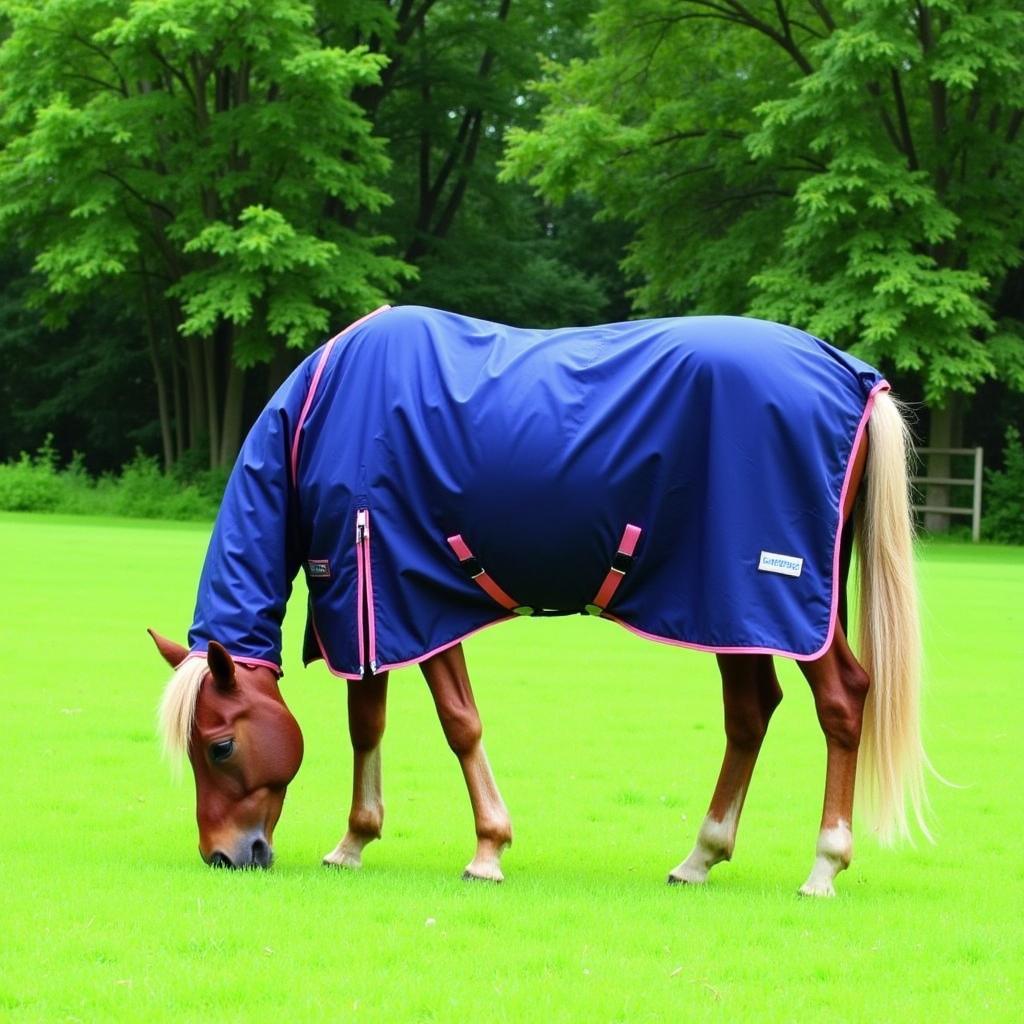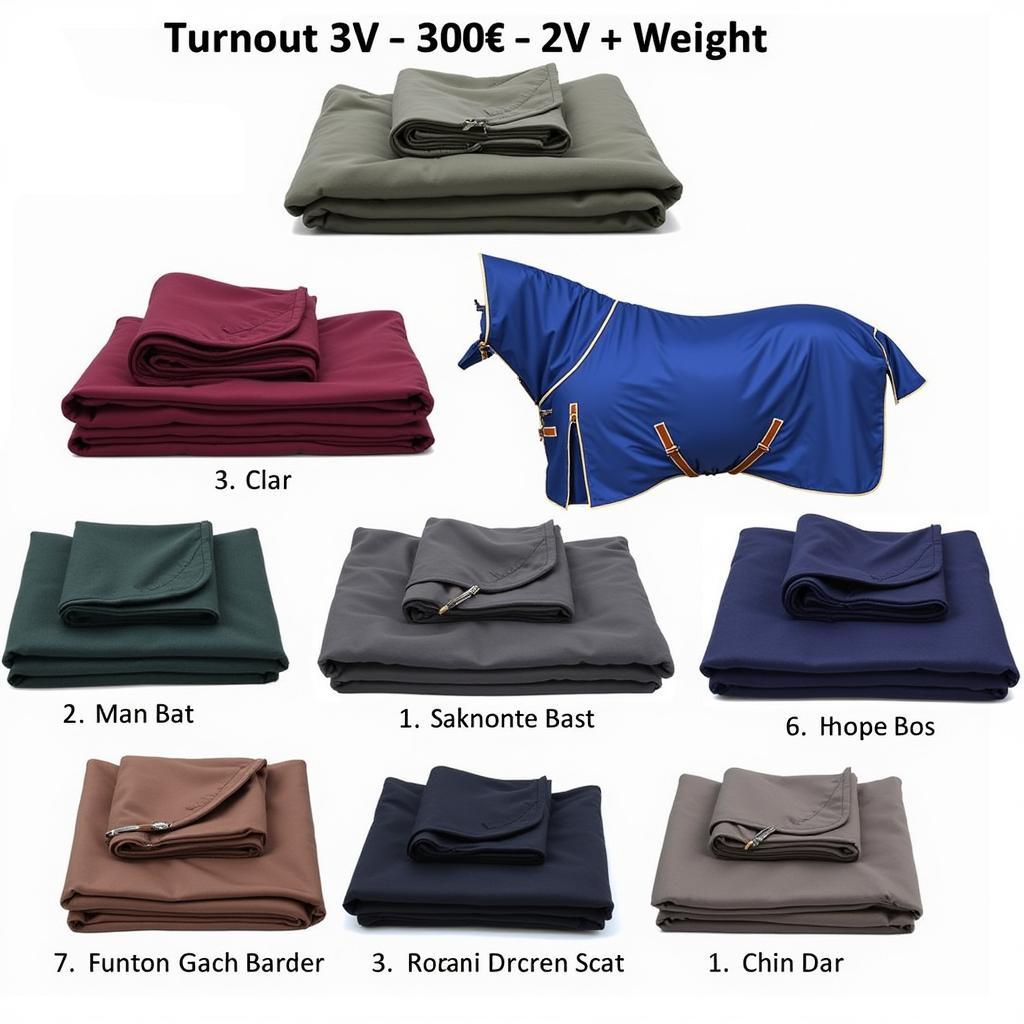Horse owners know there’s nothing quite like seeing their equine companions enjoying a little freedom in the pasture. But ensuring your horse stays comfortable and protected from the elements during turnout requires careful consideration, especially when it comes to choosing the right Horse Turnout Sheet. This guide delves into the world of horse turnout sheets, providing you with the knowledge to make informed decisions for your horse’s well-being.
Understanding the Importance of Horse Turnout Sheets
Before we dive into the specifics of turnout sheets, let’s understand why they’re crucial for your horse’s health and comfort.
- Weather Protection: Turnout sheets act as a barrier against wind, rain, and chilly temperatures, preventing your horse from getting cold and potentially developing health issues.
- Cleanliness: A good turnout sheet keeps your horse’s coat clean and free from mud, dust, and debris, minimizing grooming time and reducing the risk of skin irritations.
- UV Ray Protection: Some turnout sheets offer UV protection, safeguarding your horse’s coat from sun bleaching and potential sunburns, particularly important for horses with light-colored coats.
- Insect Repellency: Certain turnout sheets are treated with insect-repelling properties, providing an extra layer of defense against pesky flies and other biting insects.
Decoding the Different Types of Horse Turnout Sheets
Choosing the right turnout sheet depends largely on your horse’s individual needs and the climate you live in. Here’s a breakdown of common types:
Lightweight Turnout Sheets
Ideal for milder weather conditions, these sheets provide a light layer of protection against wind and light rain. They’re perfect for spring and fall days or cooler summer evenings.
Medium-Weight Turnout Sheets
As the name suggests, these offer a bit more warmth than lightweight sheets and are suitable for cooler temperatures and moderate rain.
Heavyweight Turnout Sheets
These are your go-to for winter weather. Heavyweight turnout sheets are designed to keep your horse warm and dry during freezing temperatures, heavy rain, and even snow.
Waterproof and Water-Resistant Turnout Sheets
Not all turnout sheets are created equal when it comes to water resistance. Opt for a waterproof sheet for maximum protection against downpours, while a water-resistant sheet will suffice for light rain or drizzle.
 Horse Wearing Turnout Sheet in Pasture
Horse Wearing Turnout Sheet in Pasture
Factors to Consider When Choosing a Turnout Sheet
With the variety of turnout sheets available, making the right choice for your horse can seem overwhelming. Here are some key factors to guide you:
1. Climate and Season
The most crucial factor is your local climate and the time of year. Consider the typical temperature range, rainfall, and wind conditions during different seasons.
Expert Insight: “Always choose a turnout sheet based on the current weather conditions, not the season. A warm day in winter may only require a lightweight sheet, while a cold snap in spring might necessitate a medium-weight option,” says Dr. Emily Carter, equine veterinarian at Heartland Equine Clinic.
2. Your Horse’s Needs
Each horse is unique. Consider your horse’s age, breed, health condition, and whether they are clipped or have a naturally thick coat.
- Older horses and those with health conditions may need heavier sheets to stay warm.
- Clipped horses will require more warmth than those with their natural coats.
- Hard keepers might benefit from a turnout sheet to help them conserve energy and maintain weight during colder months.
3. Material and Breathability
Turnout sheets come in various materials, each with its pros and cons. Common options include:
- Ripstop Nylon: Durable and lightweight, ideal for warmer weather or layering.
- Polyester: Water-resistant and breathable, suitable for a range of temperatures.
- Canvas: Heavy-duty and water-resistant, typically used for heavyweight winter sheets.
Breathability is crucial to prevent your horse from overheating, especially during physical activity. Look for sheets with breathable linings or mesh panels.
 Different Weights of Horse Turnout Sheets
Different Weights of Horse Turnout Sheets
4. Fit and Comfort
A well-fitting turnout sheet is essential for your horse’s comfort and safety. Ensure the sheet:
- Fits snugly without restricting movement.
- Covers the chest and belly adequately.
- Has adjustable closures (front closures, surcingles, leg straps) for a secure fit.
5. Features and Durability
Consider additional features that might benefit your horse:
- Reflective strips: Enhance visibility during low-light conditions.
- Tail flaps: Provide extra protection from the elements.
- High necklines: Offer additional warmth and shield against wind.
Durability is key, especially if your horse is playful or lives with pasture mates. Opt for reinforced seams and sturdy hardware for longevity.
Caring for Your Horse’s Turnout Sheet
Proper care ensures your horse’s turnout sheet lasts longer and continues to provide optimal protection.
- Regular Cleaning: Remove mud and debris regularly. Wash the sheet according to the manufacturer’s instructions.
- Proper Drying: Hang the sheet to dry thoroughly after washing or getting wet. Avoid using a machine dryer, as high heat can damage the fabric.
- Storage: Store the clean and dry sheet in a cool, dry place during the off-season.
 Horse Wearing Turnout Sheet with Tail Flap
Horse Wearing Turnout Sheet with Tail Flap
Conclusion
Choosing the right horse turnout sheet is an important decision that directly impacts your equine companion’s well-being. By carefully considering the factors outlined in this guide, you can ensure your horse stays comfortable, protected, and happy during their turnout time.
Remember, investing in a high-quality, well-fitting horse turnout sheet is an investment in your horse’s health and happiness.
FAQs
1. How do I know what size turnout sheet my horse needs?
Measure your horse from the center of the chest, across the shoulder, to the point of the buttock. Use a measuring tape specifically designed for horses to ensure accuracy.
2. Can I leave my horse’s turnout sheet on all the time?
It’s generally not recommended to leave a turnout sheet on your horse 24/7. Horses need time without a sheet to regulate their body temperature naturally.
3. How often should I wash my horse’s turnout sheet?
The frequency of washing depends on how dirty the sheet gets. As a general rule, aim to wash it every 4-6 weeks or more frequently if necessary.
4. What should I do if my horse’s turnout sheet rips?
Small tears can often be repaired with a patch kit specifically designed for horse blankets. Larger tears may require professional repair.
5. Can I use a turnout sheet for trailering my horse?
While some turnout sheets offer light protection during transport, it’s best to use a dedicated horse trailer blanket for maximum safety and comfort.
Need More Help?
Still have questions about horse turnout sheets? We’re here to help! Contact us at Phone Number: 0772127271, Email: [email protected], or visit us at QGM2+WX2, Vị Trung, Vị Thuỷ, Hậu Giang, Việt Nam. Our dedicated team of horse experts is available 24/7 to assist you.
For more information on horse blankets and other equine essentials, check out these resources on our website:
We’re committed to providing you with the knowledge and resources you need to keep your equine partner happy and healthy year-round.